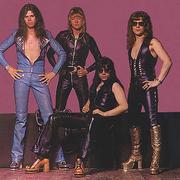Sweet
by Stephen Thomas Erlewine In some ways, the Sweet epitomized all the tacky hubris and garish silliness of the early 70s. Fusing bubblegum melodies with crunching, fuzzy guitars, the band looked a heavy metal band, but were as tame as any pop group. It was a dichotomy that served them well, as they racked up a number of hits in both the U.K. and the U.S. Most of those hits were written by Nicky Chinn and Mike Chapman, a pair of British songwriters that had a way with silly, simple, and catchy hooks. Chinn/Chapman and Sweet were smart enough to latch on to the British glam rock fad, building a safer, radio-friendly and teen-oriented version of Queen, T. Rex, and Gary Glitter. By the end of the 70s, the groups time at the top of the charts had expired but their hit singles lived on not only as cultural artifacts, but also as the predecessors for the pop-metal of the 80s. Originally, the Sweet were called the Sweetshop and consisted of Brian Connolly (vocals), Mick Tucker (vocals, drums), Frank Torpey (guitar), and Steve Priest (bass). In 1970, the group truncated their name to Sweet and signed a record contract with Fontana/EMI, releasing four unsuccessful singles. Following the failure of the four singles, Torpey left the group and was replaced by Andy Scott. The new lineup of Sweet signed to RCA Records in 1971, where they were placed under the direction of songwriters Nicky Chinn and Mike Chapman. Chinn and Chapman wrote a number of light bubblegum pop songs for the group, the first of which, Funny Funny, reached number 13 on the U.K. charts. Following Funny Funny, the duo wrote five more Top 40 hits for the group — including Little Willy and Wig-Wam Bam — which were all lightweight bubblegum numbers loaded with double entendres. During this time, Sweet were writing their own B-sides and album tracks. All of the groups compositions were harder than Chinn and Chapmans songs, featuring crunching hard rock guitars. Consequently, the duo decided to write tougher songs for the group. Blockbuster, the first result of Chinn and Chapmans neo-glam rock approach, was the biggest hit Sweet ever had in the U.K., reaching number one on the charts in early 1973 and eventually going platinum. For the next two years, Sweet continued to chart with Chinn and Chapman compositions, including the Top Ten hits Hell Raiser, Ballroom Blitz, Teenage Rampage, and The Six Teens. By the summer of 1974, the members of Sweet had grown tired of the control Chinn and Chapman exerted over their career and decided to record without the duo. The resulting album, Sweet Fanny Adams, reached number 27 in the U.K., but it yielded no hits. In the spring of 1975, Sweet had their first self-penned hit with Fox on the Run, which reached the Top Ten in both the U.K. and the U.S. Fox on the Run appeared on the collection Desolation Boulevard; in America, its release helped Ballroom Blitz reach the Top Ten in the summer of 1975. Strung Up, released in the fall of 1975, continued the groups move toward album-oriented rock. For the rest of the decade, the group continued to churn out albums, which were all less successful than their predecessor. Sweet bounced back into the charts in 1978 with Love Is Like Oxygen, but the single proved to be their last gasp; they never reached the Top Ten again, neither in the U.S. or the U.K. Connolly left the band after Love Is Like Oxygen and the group replaced him with keyboardist Gary Moberley. The group carried on for three more years, releasing three more albums that all achieved little success. After several years of little success or attention, Sweet broke up in 1982. In the decade following their breakup, Sweet reunited on various occasions. In 1985, a dance club medley of their hits called Its the Sweet Mix became a British Top 50 hit and, following the singles success, the group re-formed for a tour that proved to be less anticipated than expected. Later in the decade, Scott toured as part of the group Paddy Goes to Holyhead. In 1989, Scott and Tucker re-formed Sweet to record a live album at Londons Marquee Club.


 The Ballroom Blitz - Sweet
The Ballroom Blitz - Sweet



























![[STATION] aespa《Dreams Come True》MV Teaser - aespa (에스파)](https://img2.kuwo.cn/wmvpic/324/79/54/2120387380.jpg?imageView2/1/w/195/h/130/format/jpg/q/60)





